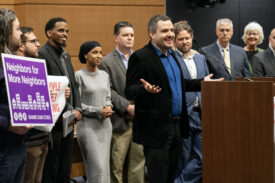 In two recentposts, I argued that urban high-rise apartments—as are being proposed for downtown Seattle—can be good for housing affordability. But in a thoughtful comment on one of my posts, Sheldon Cooper from Homestead Community Land Trust argues out that high-density urban redevelopment can crowd out affordable housing, not increase its supply.
In two recentposts, I argued that urban high-rise apartments—as are being proposed for downtown Seattle—can be good for housing affordability. But in a thoughtful comment on one of my posts, Sheldon Cooper from Homestead Community Land Trust argues out that high-density urban redevelopment can crowd out affordable housing, not increase its supply.
Now, who’s right?
I actually think we both are, since we were talking about slightly different things—both of which are important, and which (sadly) can be at odds with one another.
Obviously enough, affordability is in the eye of the beholder. What’s affordable for one group—say, middle-income households—may be completely out of reach for those at a lower income ladder. Which leads to a potential problem: a trend that can make housing more affordable for middle-income earners can, in theory at least, make housing less affordable for the poor.
At the risk of putting words in Sheldon’s mouth, I think that he’s concerned that high-rise development proposed in Seattle will physically displace some low-income housing close to downtown, while the accompanying gentrification will increase rental costs; and that the market simply won’t magically provide decent housing for people who don’t have enough money to pay for it.
Those seem like reasonable things to worry about.
Now, while the broad, structural problems with low-income housing affordability appear to be very real (pdf link), there are some researchers who believe that the problems of gentrification per se are generally overblown. But in the case of the South Lake Union development in Seattle, I don’t know what to think. I certainly believe that increasing the supply of housing in any city tends to reduce the pressure on housing prices and rents overall. But for the poor—those whose incomes are so low that what they can afford to pay won’t even cover the construction costs for decent housing, particularly in high-rises—the issues may be less cut-and-dry.
Which leads to the obvious question: what’s the right thing to do to help make housing affordable for those at the bottom rungs of the income ladder?
I just read through this book on the subject—it’s a compilation of papers on smart growth and housing affordability, edited by Brookings Institution scholar Anthony Downs. Firm conclusions are scarce in the volume. For example, Sheldon’s preferred solution—which is for city governments to allow developers to build more units than zoning codes would otherwise allow, provided that the developers set aside a certain share of affordable units in their developments—has been implemented in one form or another in some 600 jurisdictions across the US, but with surprisingly few tangible successes. The practice seems to have worked fairly well in one jurisdiction (Montgomery County, Maryland), but results elsewhere have been poor, perhaps because of a lack of political will. That doesn’t mean that these kinds of steps are misguided, just that they may not be sufficient to address the problems.
Which is really the point—while the clearest way to make housing more affordable for the middle class is to create more housing, you need a bunch of different strategies to "fix" housing affordability for those whose incomes are much lower.
Downs makes some good points in his closing chapter. First, much of the denser development touted by "new urbanists" and "smart growth" advocates really is affordable to working class and moderate-income households—those with incomes at least 50 percent of the area’s median. But it’s usually unaffordable for those at or near the poverty line. For those folks, there are two basic strategies that can work to make housing more affordable: increase incomes (as with tax credits, housing subsidies, and the like) and reduce housing costs. And you can reduce costs by…
- making financing cheaper or more available;
- reducing the costs of producing housing units by, for example, modifying building codes, speeding up the development process, or raising residential densities
- reducing the size and quality standards for new housing
- expanding the total supply of housing through new construction.
A combination of strategies might work pretty well—a city that really wanted to produce housing that’s affordable to the poor might take some or all of them.
But the kicker is that there’s very little economic motivation to do any of these things. People who already own homes generally want housing costs to go up, not down; and since homeowners tend to dominate local politics, the goal of most local governments is to keep housing costs high. Which means, among other things, that governments often create obstacles to creating new housing, whether for middle-income or lower-income residents.
So in that context, Mayor Nickels’ support for increasing the housing supply within city limits is a victory of sorts. An even greater victory, though, would be a public commitment to improving housing affordability not just for the middle class, but also for the city’s neediest residents.









GILDACARSON31
It’s well known that money makes us independent. But how to act when someone has no cash? The one way is to get the home loans and short term loan.